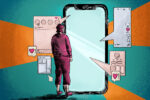It’s already May, and the COVID-19 pandemic has not miraculously disappeared. The virus still looms large over everyday life, wreaking havoc on the economy and raising concerns about mental health, both for those in isolation and for those on the front lines. As the protests across many states show, our current lockdown measures are not a sustainable solution. Unless the pandemic evaporates into thin air very, very soon, we’re going to have to have to find some sort of middle ground to create a pandemic-resilient society.
Harvard’s “Roadmap to Pandemic Resilience,” written by a bipartisan group of experts from various fields, is the first comprehensive plan for reopening the United States economy in a safe and sustainable manner. Much like the White House’s current plan for reopening the economy, the Roadmap is broken into stages, each of which has a specified timeline.
The ultimate goal within each of these phases is to protect the American people from the disease while maintaining civil liberties and galvanizing the economy. In order to carry out this goal, the plan looks to avoid disease spikes that would cause more deaths and the repeated opening and closing of various economic sectors.
Not only would these spikes ravage the economy and Americans’ trust in government, they could also prolong the pandemic to two years or more. Crucial in preventing such disastrous happenings is the three-pronged approach of mass testing, contact tracing and supported isolation outlined in the Roadmap.
Phase 1: Stabilize Essential Sectors
Currently, about 40% of the population are working as essential personnel at places such as grocery stores and hospitals, but because of a lack of testing and personal protective equipment, these workers are constantly at risk of infection. They could also already be infected and without symptoms, spreading the virus to their fellow essential employees as well as any customers with whom they interact.
The first step in the pandemic resilience plan is to support these workers with continuous testing, as well as sick leave and supported isolation if they test positive. Others who had been training for the job could step into a sick worker’s place temporarily to ensure that the business can continue to run, and dedicated contact tracers would inform those who had come into contact with the sick worker so that they could also receive testing. Those in frequent contact with essential workers, such as people in nursing homes or prisons, would also receive regular testing in order to find and isolate outbreaks.
For those of us isolating at home, there’s not much to do in this phase, except perhaps train to fill in for an essential worker if possible; it’s really all about ensuring that those on the front lines are safe, protected and supported. Ideally, this phase would begin in May so that we could move on to phase 2 as quickly as possible.
Phase 2: Expand Essential Workers
Shelves are still conspicuously bare of some essential products such as toilet paper and disinfectant wipes, but phase 2 would look to fix that. In phase 2, currently slated to begin in July, the essential workforce would be expanded to lighten the load on current essential workers and address issues in supply chains. This, of course, entails even more testing and contact tracing — and even more essential workers hired to do those jobs.
As the economy reopens, we will have to scale up testing to administer at least 20 million tests a day. As of now, the responsibility for administering tests rests solely on the shoulders of the states, but with this massive demand for more tests, the federal government needs to get involved — and the measly $25 billion the federal government allocated to testing and contact tracing in the most recent funding bill is not going to cut it. Administering 20 million tests a day would cost around $100 billion, according to economist Paul Romer.
The systems for testing and tracing will need to be flexible and durable, the specifics of each depending on the community and its needs. A highly urban area, like New York City, might use a contact-tracing app like those that have already been rolled out in several other countries, while a more rural area might have dedicated contact tracers, ideally respected and trusted community members, who would reach out by phone and trace manually.
If we are able to develop this robust system of testing and contact tracing, we could begin to relax social distancing measures for essential workers. Because they already know where the virus is, they could begin to openly visit and support each other. Still during this phase, no large gatherings would be permitted, and a good chunk of the population would be asked to stay home in order to protect this expanded workforce.
Phase 3: End Collective Stay-At-Home
Ah yes, the phase for which we’ve all been waiting. Non-essential businesses open their doors, and unemployment caused by the coronavirus officially comes to an end. Of course, public safety precautions such as wearing a mask in public and social distancing would still be in place — life would not be completely back to the pre-pandemic normal.
Those who can work from home would be asked to continue to do so for the entirety of phase 3, but phase 3 is short — only a couple of weeks. Phase 3, scheduled to begin mid-July, will last until the nation has sufficient supplies to support the entire workforce, which will hopefully be in August.
Phase 4: Full Pandemic Resilience
Phase 4 is our triumphant entrance into the new normal, when office workers can return to their workplaces and students can return to school. Of course, we will not all jump in all at once — offices may start allowing workers to come in for just a few days a week, schools may still hold some classes online. We will still need aggressive testing and contact tracing to locate and isolate the virus, and masks and social distancing would still be a must.
Businesses will need to adapt as necessary to guidelines, perhaps spacing tables further apart or reducing capacity to ensure that there’s enough space for everyone to be six feet apart. For those in places where people will be inherently packed together, like college dorms, testing will be more frequent to keep an outbreak from occurring. It won’t be exactly the same as it was before, but instead of the virus trampling all over our society and economy, both will be pandemic-resilient until researchers can come up with a vaccine or treatment.
What you need to do, as an individual citizen, is listen closely to directives in your area, be flexible and ready to do whatever you can personally to contribute to your community and voice any concerns in safe and productive ways. We are all in this together and we can do this together.

















